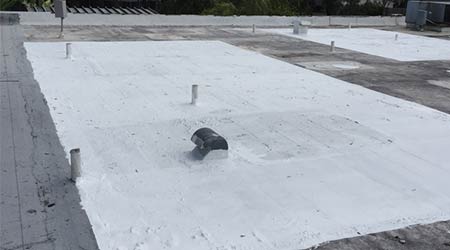Roof Inspection, Moisture Survey Vital to Repair-or-Replace Decision
Part two of a four-part article on roof assessments
Two activities can give managers the vital information they need to make a repair-or-replace decision — a detailed roof inspection and a roof moisture survey.
Weather, standing water, and foot traffic are the enemies of roofs. All three can lead to moisture penetration of the roof’s surface. While technicians can use different inspection techniques, all are looking for the impact that weather, standing water, and foot traffic have on the roof’s ability to perform.
For all roofs, the technician should closely review all flashing for failed joints, loose or missing sections, or areas where it has separated from the roof’s surface or the material it is attached to. Failed flashing is a common source of roof-penetration problems.
For all pitched roofs, inspectors should look for visible damage to the surface. For asphalt shingle roofs, typical physical damage includes cracked or missing shingles, granular loss, and curling. For tile and slate roofs, cracked or chipped tiles and missing or loose tiles are signs of trouble. For metal roofs, corrosion of panels and fasteners, damaged or loose panels, and failing fasteners require further attention.
Flat roofs require close inspection of all areas of the membrane and penetrations. Inspectors should look for signs of ponding of water, blocked or improperly installed roof drains, punctures of the roof membrane, failed seams, blisters, soft areas, and the growth of vegetation.
While visual inspections will identify damage to the roof’s surface, they will not identify areas where water penetration has damaged the insulation. Technicians can use a number of non-destructive test methods to survey a roof for damaged insulation, including infrared thermography, nuclear moisture testing, and electrical-impedance testing.
Technicians should conduct infrared thermography surveys at night. The tests produce the most accurate results when the membrane is dry, the air temperature is cool, and there is no wind. Under those conditions, the wet insulation retains the heat from the day’s sun and shows up in the scan as being warmer than dry insulation. Infrared thermography does not work well on foam or other closed-cell insulation that cannot absorb water, and several situations — mechanical equipment discharging heat onto the roof or shade that results in unequal heating during the day — can create misleading conditions.
In nuclear moisture testing, technicians expose the roof to a low level of neutron emissions. When the neutrons collide with the hydrogen in water located within roof insulation, they slow down. By detecting the change in speed of the neutrons, technicians can determine moisture levels within the insulation. They can use data from the survey to produce a map of the moisture level in the insulation. Nuclear scans are more expensive than infrared thermography, but technicians can perform them during the day.
Electrical capacitance testing works on the principle that since water conducts electricity, wet insulation will have different electrical properties than dry insulation. Testing the roof’s insulation capacitance on a grid basis produces a map of areas where water has damaged insulation.
The cost of capacitance testing is between that of infrared and nuclear moisture testing. Managers should know that the process cannot be used on some membranes that are electrical conductors, such as EPDM roofs and those with aluminum coatings.
Related Topics:
















